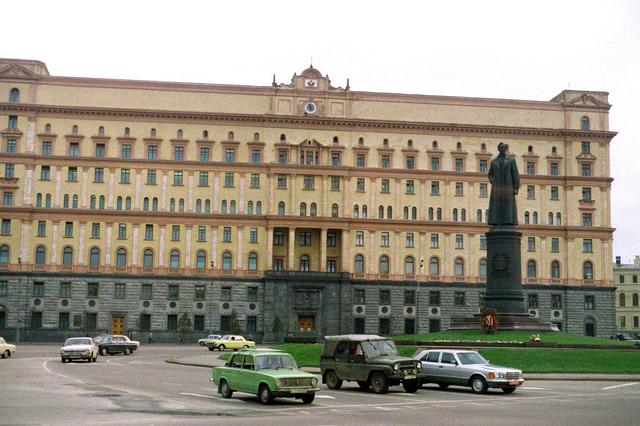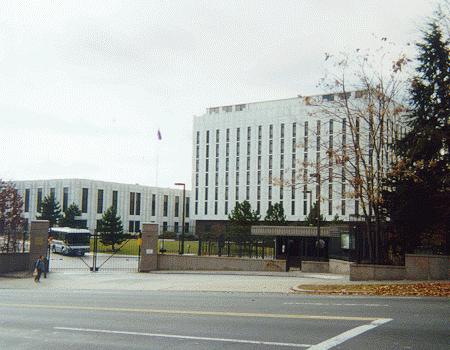




















Introduction of the Agencies
In this section we will examine the major intelligence agencies of the Cold War. On the Soviet side, there
was an all-famous KGB - the Secret Government Service. On the American side, there was a number of agencies -
the task of spying was more split between the American bureaucracy. There were also other intelligence agencies,
which played a large role in the spying of the Cold War - an excellent example being MI5 British Intelligence
Service.
We will introduce you and give a brief description of the intelligence agencies of all sides,
so you will have a better understanding of spying and intelligence services on both sides of the Iron Curtain.
Soviet Intelligence - KGB
Background
The KGB's origins date to December 1917,
when the first Soviet political police agency,
the VeCheka was created under the leadership of Feliks
Dzerzhinsky. After a series of reforms and name changes throughout Lenin's and Stalin's rule in Soviet Russia, KGB was
formed in 1954 to take over state security
functions.
 Lubyanka Square in downtown Moscow is the site of the site of the Lubyanka head-quarters of the KGB. KGB directors from Lavrentiya Beriya to Yuriy Andropov had their office on the third floor of the building. The center of the square was dominated centre by a statue of Felix Dzerzhinsky, founder of the first communist secret police
The Lubyanka actually consists of three buildings. The main yellow building, which is often shown on
television, predates the Revolution and was taken over by the Bolsheviks in 1918. Containing the Lubyanka prison,
this building is now the headquarters of the Border Troops, and it also contains a single Federal Security Service
(FSB) Directorate.
Lubyanka Square in downtown Moscow is the site of the site of the Lubyanka head-quarters of the KGB. KGB directors from Lavrentiya Beriya to Yuriy Andropov had their office on the third floor of the building. The center of the square was dominated centre by a statue of Felix Dzerzhinsky, founder of the first communist secret police
The Lubyanka actually consists of three buildings. The main yellow building, which is often shown on
television, predates the Revolution and was taken over by the Bolsheviks in 1918. Containing the Lubyanka prison,
this building is now the headquarters of the Border Troops, and it also contains a single Federal Security Service
(FSB) Directorate.
KGB, in full, Komitet gosudarstvennoy
bezopasnosti (State Security Committee),
the government agency of the Union of
Soviet Socialist Republics (USSR) in charge
of the Soviet political police from 1954 to
1991. The KGB, the last in a series of Soviet
security agencies dating from 1917, was
officially disbanded when the USSR collapsed.
During its years of operation the agency's
main directive was to protect the Soviet
regime from internal and external threats by
means of a vast police and spy network.
Purpose
The Soviet leadership needed an extensive
 security and intelligence (information) system
in order to ensure the political loyalty of the
population at home and to promote its goals
as a superpower abroad. The KGB's domestic
functions included closely monitoring the
Soviet people and suppressing expressions of
political discontent. The KGB also was
responsible for guarding Soviet borders,
protecting party and government leaders,
and enforcing security in the Soviet armed
forces.
security and intelligence (information) system
in order to ensure the political loyalty of the
population at home and to promote its goals
as a superpower abroad. The KGB's domestic
functions included closely monitoring the
Soviet people and suppressing expressions of
political discontent. The KGB also was
responsible for guarding Soviet borders,
protecting party and government leaders,
and enforcing security in the Soviet armed
forces.
The KGB had the largest and most active
foreign intelligence apparatus in the world.
Its primary mission was to further Soviet
foreign policy goals by gathering secret
political, military, and technological
information abroad and by conducting
propaganda and disinformation campaigns,
directed mainly against the West. In carrying
out its operations the KGB relied heavily on
the intelligence services of Soviet satellite
countries in Eastern Europe.
The KGB had branches duplicating many of
these functions in the 14 non-Russian
republics of the USSR. It also had offices in
every district, region, and city, as well as
special departments in all government
institutions, factories, and enterprises.

 DID YOU KNOW?
DID YOU KNOW?

The
Soviet regime never released figures on the
total number of KGB employees, but Western
estimates ranged from 400,000 to 700,000
full-time employees, exclusive of agents and
informers, during the KGB's peak in the 1970s
and 1980s.

Organizational Structure
The KGB was originally designated as a "state committee attached to the Council of Ministers."
The basic organizational structure of the KGB was created in 1954, when the reorganization of the
police apparatus was carried out. In the late 1980s, the KGB remained a highly centralized institution,
with controls implemented by the Politburo through the KGB headquarters in Moscow.

 DID YOU KNOW?
DID YOU KNOW?

The situation was similar with the Supreme Soviet, which had formal authority over
the Council of Ministers and its agencies. In 1989 the actual powers of the Supreme
Soviet, however, gave it little if any power over KGB operations.

The KGB was a union-republic state committee, controlling corresponding state committees of the same
name in the fourteen non-Russian republics.

The KGB also had a broad network of special departments in all major government institutions, enterprises, and factories. They generally consisted of one or more KGB
representatives, whose purpose was to ensure the observance of security regulations and to monitor political sentiments among employees. The special departments
recruited informers to help them in their tasks. A separate and very extensive network of special departments existed within the armed forces and defense-related
institutions.
Although a union-republic agency, the KGB was highly centralized and was controlled rigidly from the top. The KGB central staff kept a close watch over the
operations of its branches, leaving the latter minimal autonomous authority over policy or cadre selection. Moreover, local government organs had little involvement in local KGB activities.
The KGB was directed by a chairman--who was formally appointed by the Supreme Soviet but actually was selected by the Politburo-- one or two first deputy
chairmen, and several (usually four to six) deputy chairmen.
Post-Soviet Developments
KGB Spetsnaz forces were assigned to storm the Russian Parliament building early on 21 August 1991 and seize key leadership personnel, including Boris Yeltsin. However, the commanders on the scene decided not to execute the plan, and some Alpha subgroup commanders and personnel refused to take part in the action, which contributed to the failure of the coup against Gorbachev, and ultimately the collapse of the Soviet Union.
On 24 October 1991 Mikhail Gorbachev signed a decree abolishing the KGB.

The Soviet Union's Committee for State Security dissolved along with the USSR in late 1991. However, most of its assets and activities have continued through several
separate organizations.
The Foreign Intelligence Service [SVR] was the first element of the KGB to establish a separate identity incorporating most of the foreign operations, intelligence-gathering and intelligence analysis activities. The Federal Agency for Government Communications and Information [FAPSI], the Russian counterpart to the US National Security Agency. Some 8,000-10,000 troops, which guarded the Kremlin and key offices, joined the Federal Protective Service with responsibilities similar to the American Secret Service.
Click here to go on to the American Spy Agencies Page









Designed by Alec Andronikov and Baron Geluz










































 Lubyanka Square in downtown Moscow is the site of the site of the Lubyanka head-quarters of the KGB. KGB directors from Lavrentiya Beriya to Yuriy Andropov had their office on the third floor of the building. The center of the square was dominated centre by a statue of Felix Dzerzhinsky, founder of the first communist secret police
The Lubyanka actually consists of three buildings. The main yellow building, which is often shown on
television, predates the Revolution and was taken over by the Bolsheviks in 1918. Containing the Lubyanka prison,
this building is now the headquarters of the Border Troops, and it also contains a single Federal Security Service
(FSB) Directorate.
Lubyanka Square in downtown Moscow is the site of the site of the Lubyanka head-quarters of the KGB. KGB directors from Lavrentiya Beriya to Yuriy Andropov had their office on the third floor of the building. The center of the square was dominated centre by a statue of Felix Dzerzhinsky, founder of the first communist secret police
The Lubyanka actually consists of three buildings. The main yellow building, which is often shown on
television, predates the Revolution and was taken over by the Bolsheviks in 1918. Containing the Lubyanka prison,
this building is now the headquarters of the Border Troops, and it also contains a single Federal Security Service
(FSB) Directorate.
 security and intelligence (information) system
in order to ensure the political loyalty of the
population at home and to promote its goals
as a superpower abroad. The KGB's domestic
functions included closely monitoring the
Soviet people and suppressing expressions of
political discontent. The KGB also was
responsible for guarding Soviet borders,
protecting party and government leaders,
and enforcing security in the Soviet armed
forces.
security and intelligence (information) system
in order to ensure the political loyalty of the
population at home and to promote its goals
as a superpower abroad. The KGB's domestic
functions included closely monitoring the
Soviet people and suppressing expressions of
political discontent. The KGB also was
responsible for guarding Soviet borders,
protecting party and government leaders,
and enforcing security in the Soviet armed
forces.

 DID YOU KNOW?
DID YOU KNOW?



 DID YOU KNOW?
DID YOU KNOW?












